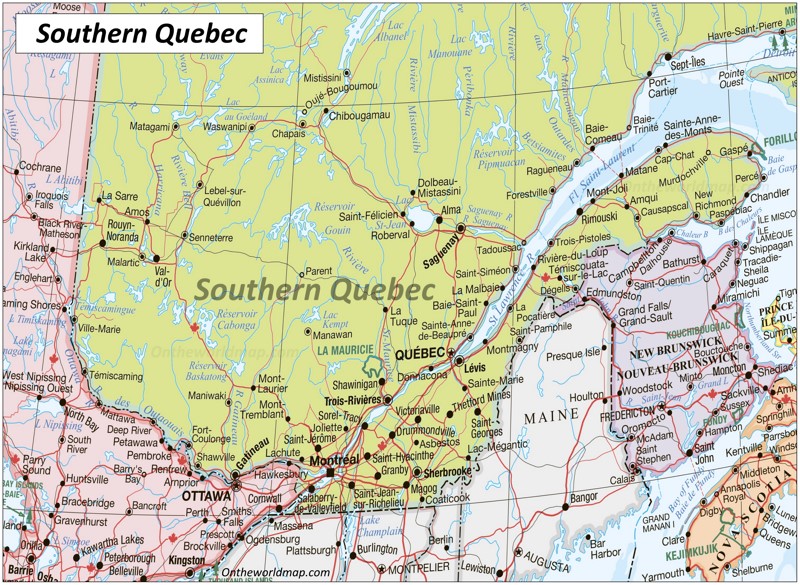Map of Southern Quebec
Description:
This map shows cities, towns, rivers, lakes, Trans-Canada highway, major highways, secondary roads, and national parks in Southern Quebec.
Size: 3025x2213px / 2.91 Mb
You may download, print or use the above map for educational, personal and non-commercial purposes. Attribution is required. For any website, blog, scientific research or e-book, you must place a hyperlink (to this page) with an attribution next to the image used.
About Southern Quebec
Based on my research, I'll now write a factual note about Southern Quebec in American English for tourists.Southern Quebec is the most populated and accessible region of Canada's largest province, situated along the fertile lowlands of the Saint Lawrence River. This area represents the cultural and historical heart of French-speaking North America, bordered by the United States to the south and extending from the Ontario border in the west to the Gaspé Peninsula in the east.
The region's geography is defined by three distinct features: the Saint Lawrence River valley, the Laurentian Mountains (Laurentides) to the north, and the Appalachian Mountains stretching through the Eastern Townships. The Saint Lawrence River, flowing from the Great Lakes to the Atlantic Ocean, serves as the region's primary waterway and has shaped its development for centuries. Southern Quebec experiences a humid continental climate with four distinct seasons, featuring warm, humid summers and cold, snowy winters with temperatures ranging from 77°F (25°C) in July to 18°F (-8°C) in January.
Quebec City, the provincial capital founded in 1608, stands as North America's only fortified city north of Mexico. Its historic district, Old Quebec, earned UNESCO World Heritage status in 1985. Visitors can explore the star-shaped Citadel, walk along nearly three miles of preserved stone walls, and admire the iconic Château Frontenac hotel. The Notre-Dame de Québec Basilica-Cathedral, dating from 1647, ranks among Canada's oldest Catholic churches. The charming Petit Champlain Quarter features cobblestone streets lined with boutiques and cafés, while Dufferin Terrace offers panoramic views of the river. Nearby, Montmorency Falls plunges 275 feet (84 meters), exceeding Niagara Falls in height.
Montreal, Canada's second-largest city, blends European charm with North American energy. The historic Old Montreal district showcases 17th and 18th-century architecture, including the magnificent Notre-Dame Basilica built in 1824. Mount Royal, the hill that gives the city its name, provides green space and city views. The Montreal Biodome and Botanical Garden attract nature enthusiasts, while numerous museums preserve the region's cultural heritage.
The Laurentian Mountains north of Montreal offer year-round recreation. Mont-Tremblant, the region's premier resort, features skiing in winter and hiking, mountain biking, and water sports in summer. Jacques-Cartier National Park, located 30 miles north of Quebec City, encompasses boreal forests, rivers suitable for canoeing, and wildlife viewing opportunities. The Eastern Townships, with their rolling hills and lakes, provide a quieter alternative with charming villages and agricultural landscapes.
For wildlife enthusiasts, the town of Tadoussac, where the Saguenay River meets the Saint Lawrence, offers exceptional whale watching from May through October. Thirteen whale species, including blue whales, frequent these waters. Île d'Orléans, a 75-square-mile island near Quebec City, was designated a National Historic Site in 1990 and preserves traditional Quebecois rural architecture and agriculture. The region celebrates its heritage through festivals year-round, most notably Quebec City's Winter Carnival in February, featuring ice sculptures, snow activities, and the famous Bonhomme mascot.
Maps of Quebec: Large detailed map of Quebec | Quebec road map | Map of Quebec with cities and towns
Maps of Canada
Provinces and Territories
Cities of Canada
Cities of Canada

